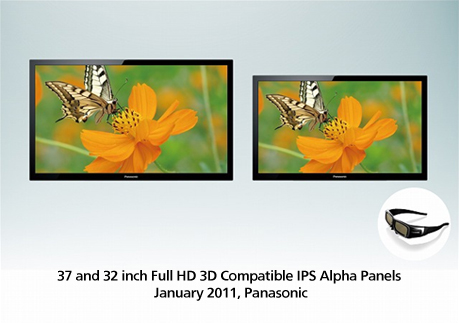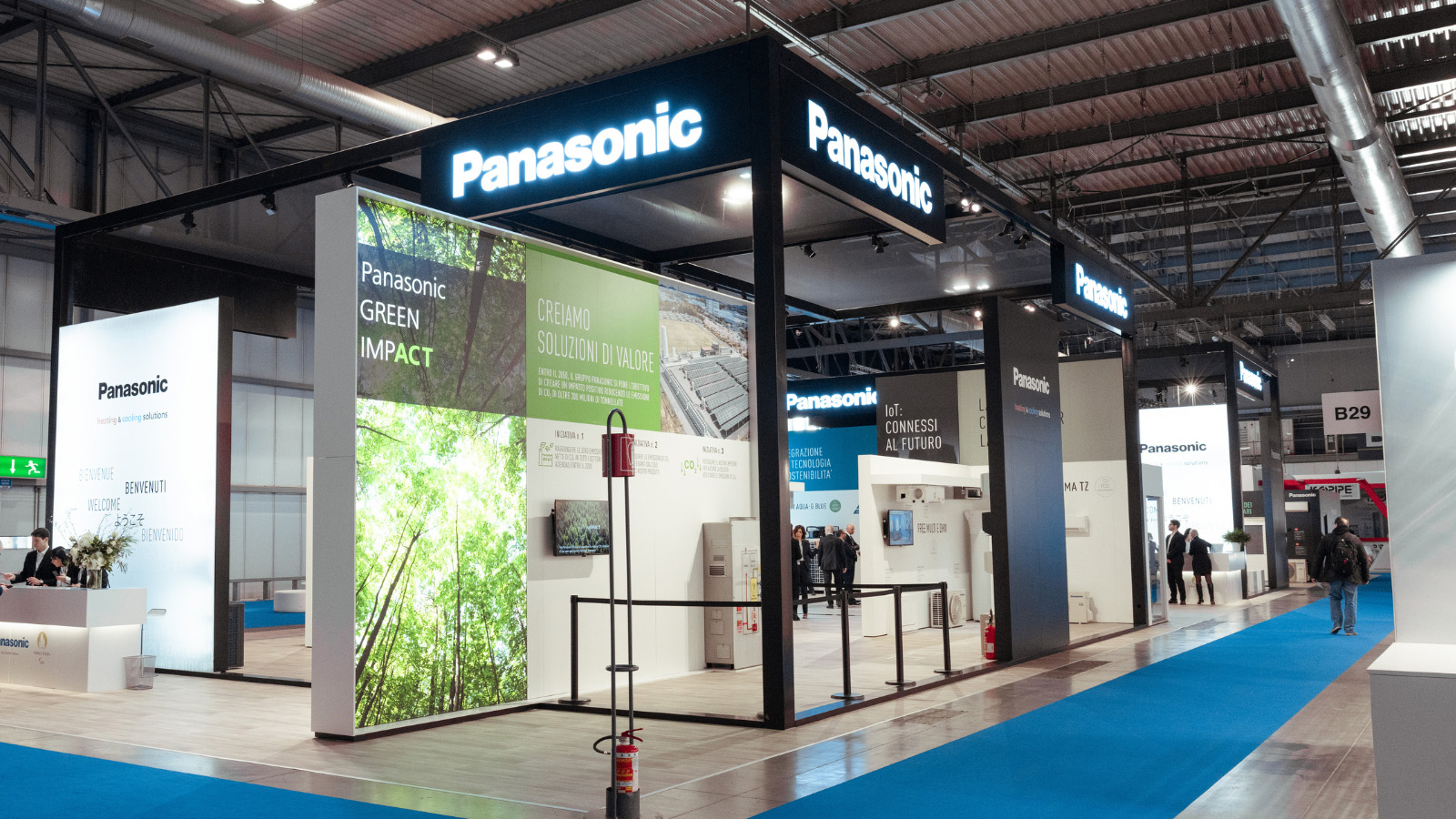Jan 06, 2011
Press Release
Panasonic Develops 32 and 37 inch Full HD 3D IPS Alpha LCD Panels
Osaka, Japan - Panasonic Corporation has developed 32 and 37 inch IPS Alpha LCD panels with LED backlight that boast the industry's fastest1 2 ms super high-speed scanning to deliver high-quality full high definition (HD) 3D video. The company plans to launch VIERA Full HD 3D LCD TVs featuring the new IPS Alpha panels in the American market this spring.
The new 3D LCD TVs are now on display at the 2011 International CES2 which started today in Las Vegas, Nevada.
When it comes to 3D, reproducing Full HD 3D images requires a display that can process massive volumes of information rapidly, over twice the speed of regular Full HD displays, because Full HD images need to be displayed alternately to left eye and right eye to create the 3D experience. Furthermore, to produce high-quality 3D images up to Panasonic's standard in par with the quality of plasma panels, crosstalk (double imaging) has to be reduced in LCD panels.
Panasonic's IPS Alpha panels have gained their reputation on a global level as excellent LCD panels that combine the industry's top-level response time and energy efficiency. Panasonic adopted its unique highly transmissive IPS-pro technology3 to develop these panels, taking advantage of the characteristics of IPS method4 devices - wide viewing angles and high light transmission rates.
To tackle these challenges, Panasonic made major changes to the whole process of panel making, from the structure to key materials in order to maximize the advantages of IPS Alpha panels. In addition through newly developed Advanced Pre-Charged Driving technology that achieves the fastest scanning rate in the industry of 2 ms1, display speed twice5 that of previous models has been achieved. As a result, Panasonic has produced LCD panels with crosstalk almost completely reduced and a solid black picture that maintains a broad gradation display, similar to its plasma panels. The LCD panels also have full moving picture resolution6 which enhances moving picture reproducibility even in 2D display. The combination of reduced crosstalk and black reproducibility enables Panasonic to deliver LCD panels with clear, superior contrast, high-quality Full HD 3D pictures, comparable to PDPs. (Further details are given on the next page)
This fiscal year, witnessing the advent of 3D TVs where the market for 3D TVs in Japan, Europe, and the U.S. has expanded and the products popularity in developing countries has increased, Panasonic has introduced its 3D TV to 80 countries around the world. The industry demand is expected to grow globally to 40 million units in 2012 as more 3D content becomes available (according to research by private company).
Growth in demand for 3D displays is also expected to accelerate as they fulfill not only consumer needs but also respond to increased interest from such fields as broadcasting, corporate, commercial and medical applications.
In 2010, Panasonic launched its Full HD 3D plasma TVs globally as PDPs are deemed as highly suitable device to reproduce 3D images because of their characteristics such as large-size, high picture quality and fast moving picture response time. Panasonic Full HD 3D plasma TVs have received high acclaim from various sectors worldwide, including the Charles Wheatstone Award7 from the International 3D Society.
With the development of the new 3D IPS Alpha LCD panels, which will add mid-size models to Panasonic VIERA 3D TV line, and large-sized 3D PDPs, Panasonic continues to lead the 3D TV market and meet the wide-ranging needs of customers worldwide, including the business customers.
<Key Features of the New Panel>
1. New super high-speed 3D LCD scanning (Advanced Pre-Charged Driving) technology
Crosstalk reduction in LCD panels was considered difficult in principle because they use a line-at-a-time driving method, whereas PDPs use a frame-at-a-time driving method. Using the newly-developed super high-speed 3D LCD scanning technology, however, Panasonic has achieved a super scanning speed of 2 ms1, the fastest in the industry. Further, this technology minimizes the overlap of left and right images to produce natural 3D video.
2. New 3D high-speed response panel
Panasonic has accelerated the LCD panel's response speed twice as fast as the previous models by thinning the liquid crystal layer and using a newly developed high-fluidity liquid crystal material. Because IPS panels feature fast response time regardless of panel temperature or color gradation, the new 3D IPS panels can deliver high-definition 3D video stably immediately after switched on.
In addition to the above technologies, the new 3D IPS LCD panels also use Panasonic's newly-developed 3D signal processing algorithm to reduce crosstalk according to the video data scanned beforehand and reproduce smooth images from 24 Hz video source such as movies, thus achieving realistic 3D video with rich texture.
Notes:
| 1) | Time required to scan a frame of 3D video on an LCD TV (as of January 6, 2011, according to research by Panasonic). |
| 2) | Held from January 6 to 9 at the Las Vegas Convention Center. |
| 3) | IPS LCD panel technology that utilizes unique design for high transmissive rates with use of transparent electrodes etc. |
| 4) | IPS LCD is an abbreviation of In-Plane Switching TFT LCD and provides an LC mode with high picture quality, which allows for beautiful images from any angle. Since the liquid crystal molecule rotates on the surface parallel to the TFT substrate due to in-plane switching, the IPS system, in principle, delivers a wider viewing angle, superior color reproducibility, and faster half-tone response. It also provides a natural image regardless of the viewing angle, with minimum color-tone variations. |
| 5) | Compared with Panasonic's IPS Alpha panels shipped in the fiscal year through March 2011. |
| 6) | Moving picture resolution, expressed as a number of lines, indicates the degree of detail that the human eye can distinguish (a measuring method used by the Advanced PDP Development Center). Full video resolution is 1080. |
| 7) | On October 19, 2010, Panasonic received the Charles Wheatstone Award, the highest honor of the inaugural 3D Technology Awards presented by the International 3D Society (I3DS). |

About Panasonic
Panasonic Corporation is a worldwide leader in the development and manufacture of electronic products for a wide range of consumer, business, and industrial needs. Based in Osaka, Japan, the company recorded consolidated net sales of 7.42 trillion yen (US$79.4 billion) for the year ended March 31, 2010. The company's shares are listed on the Tokyo, Osaka, Nagoya and New York (NYSE:PC) stock exchanges. For more information on the company and the Panasonic brand, visit the company's website at http://panasonic.net/.
Media Contacts:
- Overseas Public Relations Office
- Panasonic Corporation
- Tel: 03-6403-3040 Fax: 03-3436-6766
- Panasonic News Bureau
- Tel: 03-3542-6205 Fax: 03-3542-9018
Banner area begins from here.
The content in this website is accurate at the time of publication but may be subject to change without notice.
Please note therefore that these documents may not always contain the most up-to-date information.
Please note that German, French and Chinese versions are machine translations, so the quality and accuracy may vary.






